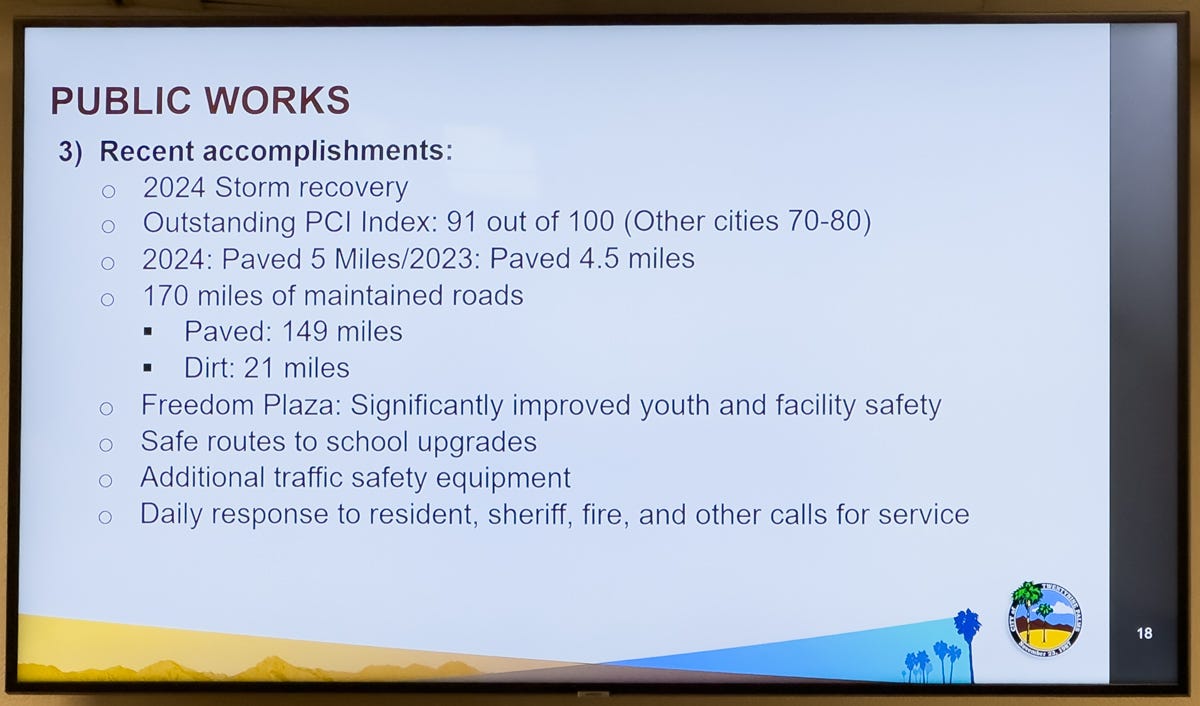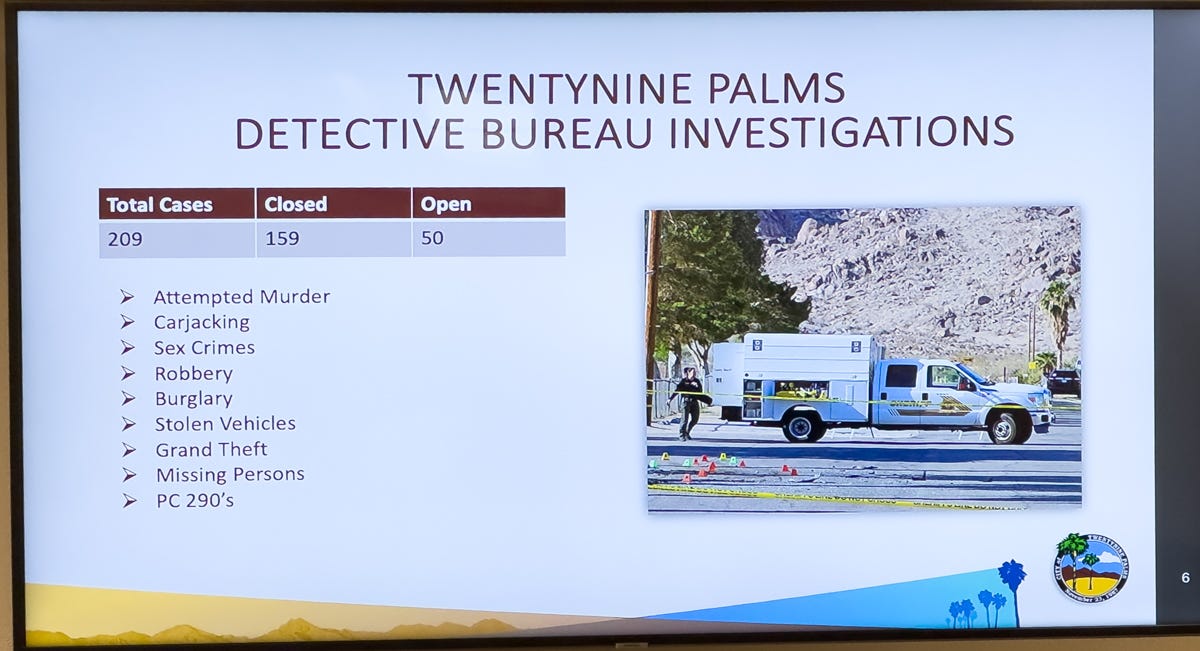Twentynine Palms' Strategic Planning: Many Needs, Little Revenue, Part 5
This final look at the City's departments includes Public Works, the Sheriff's Department, Solid Waste & Recycling, and the Tourism Business Improvement District
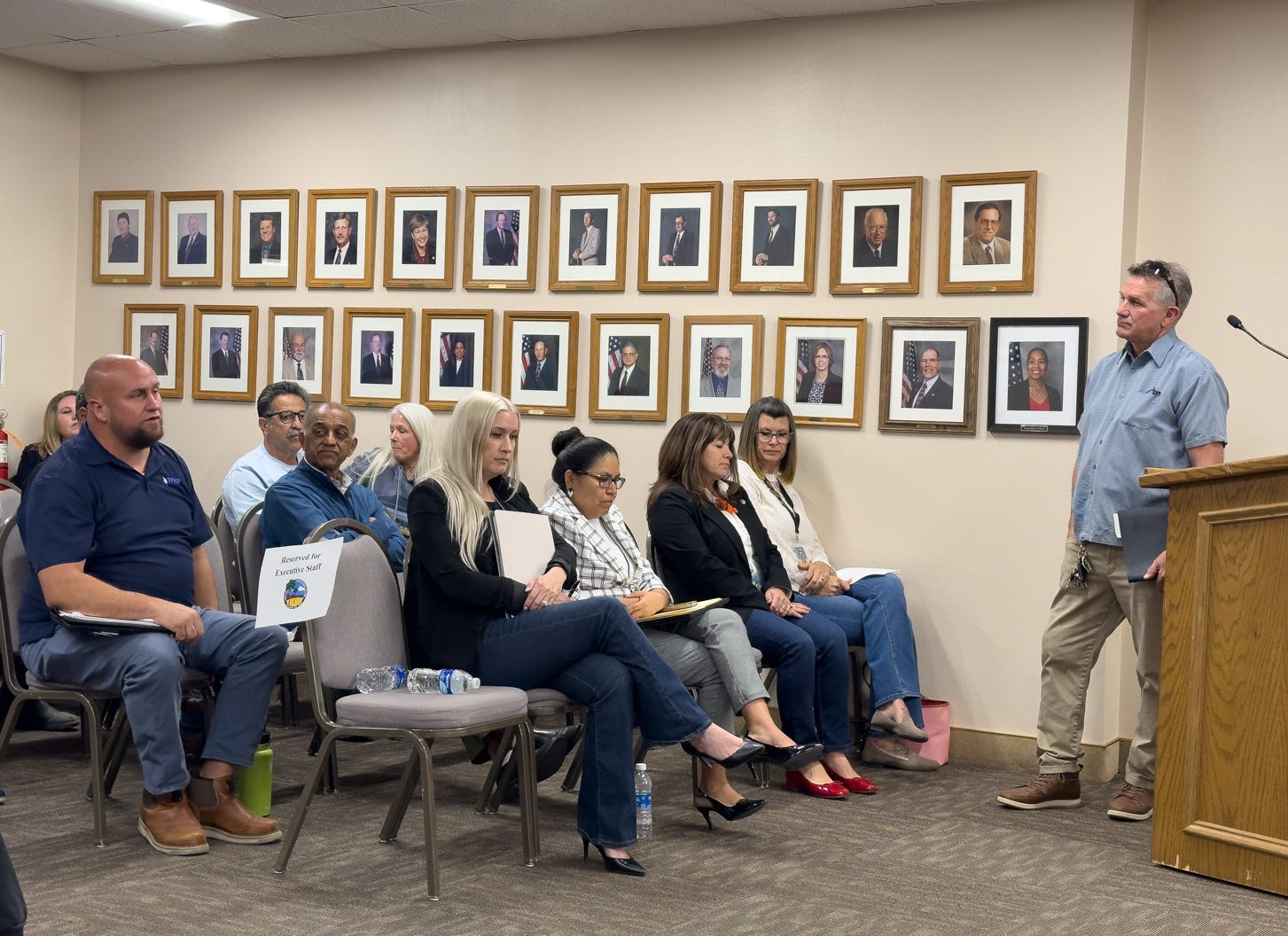
At long last, we’ve reached the end of our reporting on April fourth’s four-hour cavalcade of 13 City departments and partners. Although the City’s strategic planning process took place six weeks ago, the Desert Trumpet thinks it’s useful for Twentynine Palms residents to understand just what it is City government does and aspires to do. This is the fifth and final part of our report on that epic early April meeting.
Departments are presented alphabetically instead of following the order of the evening. The reporting below is based on the information supplied in the meeting.
Part 1: Animal Shelter, Animal Control and the City Clerk’s office
Part 2: Community Development and Emergency Management
Part 3: Finance and Fire services
Part 4: Human Resources/Risk Management, Information Services, and Parks and Recreation
While there were several questions and some discussion between Council, presenters, and residents, no microphone was provided to the public. We’ve done our best to capture those conversations. We are listing the names of the public and Council members commenting, and quoting from selected comments.
Public Works
Presenting: Craig Stacey, Public Works Superintendent
Purpose: To maintain and enhance the city's infrastructure—including roads, parks, and public facilities—by prioritizing safety, efficiency, and sustainability, all while operating with limited staff and budget. The team supports 150 miles of paved roads, 20 miles of maintained dirt roads and maintains public parking areas and City spaces such as Freedom Plaza.
Staffing: Five park staff, five road staff and two supervisors
Projects / Accomplishments:
Storm Response (2023-24): Rapid recovery following major storm events
Road Overlay Program: In-house paving saved 30–40% over contracting; Pavement Condition Index (PCI) among highest in the region; road paved 24 years ago still in strong condition due to robust overlay, not micro-paving
Safe Routes to School Grants: Six projects in five years including key intersection safety upgrades
Freedom Plaza Enhancements: Safety and cleanliness improvements near bathrooms with added doors and hallway closure
In-House Sign Fabrication: Saved around $700,000 by fabricating signs internally for a total cost of around $300,000; created event-specific signs
Bike Path Expansion: 4 miles added; Sullivan-Hatch project in design/easement stage to connect paths to Sky Park
SB1 Reporting & Compliance: Maintains eligibility and funding stream for paving projects through efficient tracking and reporting
ADA Upgrades: Ongoing upgrades to facilities and parking lots
Flood Warning System: Will install lit flood warning signs before the 2025 season
Future Needs:
Equipment Replacement / Repair: Aging equipment; some trucks with 380k–930k miles; emissions compliance with the California Air Resources Board (CARB) could force significant expenditures by 2027; Public Works is engaging with CARB-compliant vendors to monitor and plan for changes
Traffic Signal Upgrades: Five intersections have failing, outdated components; replacements require different scopes of work; vendor recommends one per year over five years
Generator Replacements: More backup power sources needed at facilities for emergency preparedness
Council comment: April Ramirez
Public Comment: Carlos Blandon, Linda Chartier, Matt Shragge
Desert Trumpet take-away: Councilmember Ramirez thanked Mr. Stacey, saying, “my kids and I, I'm like, “Hold on, guys, we're going down the bumpy road,” or “It's okay, guys, you guys can relax. We're on a good road.” Like many City departments, Public Works does heroic work with limited resources. They particularly excel in maintaining their vehicles as well as the City’s roads, with all of their many challenges.
SAN BERNARDINO COUNTY SHERIFF
Presenting: Robert Warrick, Captain, Morongo Basin Patrol Station
Purpose: The Sheriff's Department aims to ensure public safety in 29 Palms through patrols, investigations, community engagement, and specialized services.

Accomplishments:
Call Volume and Arrests: Responded to more than 17,600 calls for service; handled nearly 2,000 reports and made approximately 1,300 arrests; took part in 13 federal arrests.
Detective Staffing: Added a second detective in 2024; solved 159 of 209 assigned cases—a 75%+ clearance rate; improved case distribution and response for serious crimes, including attempted murder and carjacking.
K-9 Program: Deployed K-9 Naji (tracking/trailing canine), active in schools and community events; Naji found 10 individuals, including a robbery suspect, a missing demential patient; and a fleeing dirt bike suspect
OHV Response Capability: acquired off-highway vehicle (OHV) for difficult terrain response; planned education initiatives using OTS grant funding to address legal vs. illegal riding issues.
Countywide Support Operations: ongoing response to illegal marijuana grows (reduced from 100+ to near zero); regular support from homicide detail, SWAT, narcotics, aviation (helicopter), and dive rescue teams.
Emergency Response: deployed 28 personnel within 90 minutes during 2024 flooding emergency; activated swift water and dive rescue teams for community safety.
Remote Reporting System: 193 calls and 84 reports handled remotely by dispatch headquarters staff; increased efficiency and reduced wait times for non-emergency cases.
Community Engagement: Participated in graduation events, National Night Out, Shop with a Cop, Coffee with a Cop and more.
Future Needs:
Sheriff’s Service Specialist (SSS): this cost-effective position ($85,000 vs. $200,000 a year for a deputy sheriff) to assist with community event coordination; traffic collision and non-emergency reporting; evidence collection and investigation follow-ups—leaving sworn deputies to work with emergency situations
Council comment: None
Public Comment: None
Desert Trumpet Takeaway: The work of the Sheriff’s Department is essential to the City. That said, it’s the largest part of the budget—and growing. Nonetheless, adding a Sheriff’s Service Specialist could significantly enhance both community engagement and operational bandwidth at a much lower cost than hiring another sworn deputy.
SOLID WASTE & RECYCLING
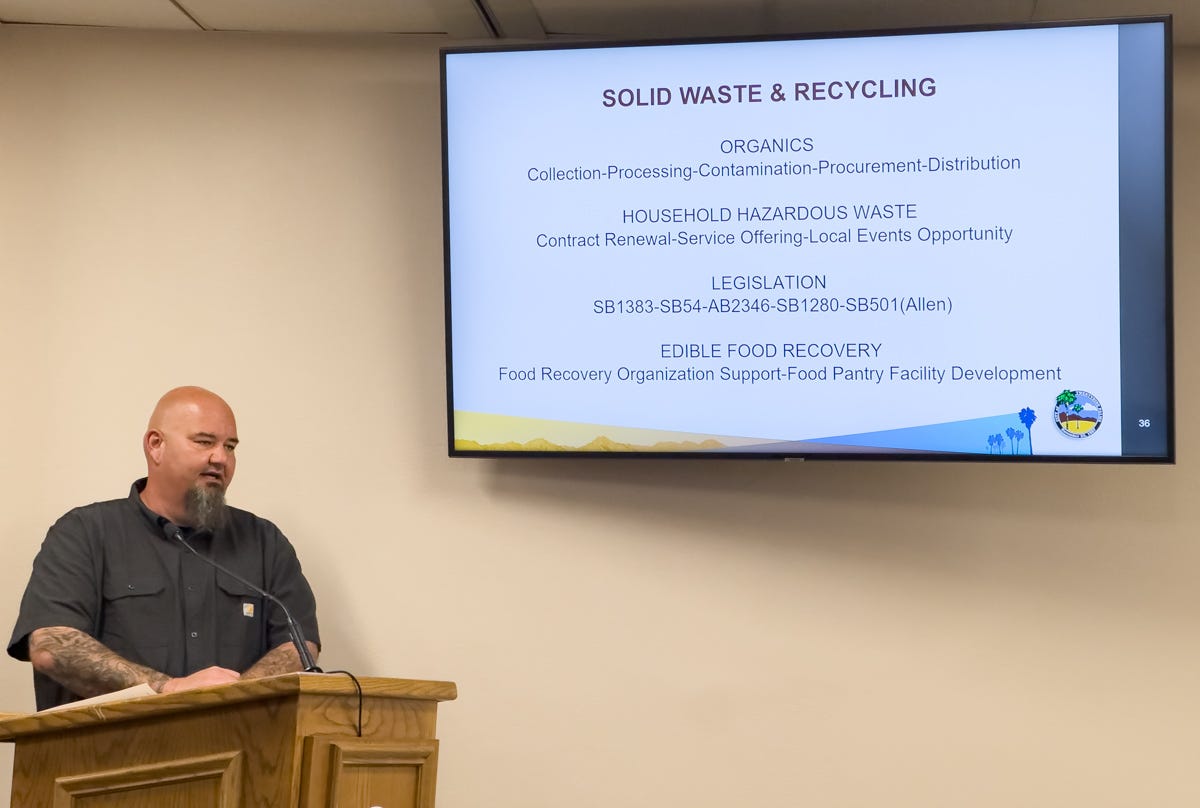
Presenting: Elijah Marshall, Director of Information Services
Purpose: Managing the collection and recycling of household recycling, organic waste, household hazardous waste and involved in edible food recovery.
Staffing: One full time, shared with Information Services
Projects / Accomplishments:
Partnership with Mojave Desert and Mountain Recycling Authority to conduct a local waste characterization study under AB 2346.
Maintained household hazardous waste access through San Bernardino County Fire (despite cost increases).
Implemented green cart composting program (material processed in Yucca Valley and turned into compost).
Past pilot program gave away 300 refillable propane canisters.
Local compost giveaway events underway.
Ongoing partnerships with nonprofits for edible food recovery and redistribution.
Future needs:
Evaluate and potentially adjust the environmental fee on trash service to fund future edible food recovery infrastructure.
Anticipate increased cost of the hazardous waste contract renewal in 2027 (projected $150,000+).
Plan for potential failure of current nonprofit food recovery capacity by exploring public-private or nonprofit partnerships, with City support through grant-funded assets.
Monitor and prepare for impacts from SB 1260 banning single-use propane cylinders (potential tourism/tourist service disruption).
Stay engaged with CalRecycle’s evolving Zero Waste Plan, which proposes banning single-use packaging and closing landfills by 2040.
Council Comment: Octavious Scott (during public comment)
Public Comment: Robin Schlosser, Linda Chartier, Carlos Blandon, Matt Shragge
Desert Trumpet take-away: Public comments focused on edible food recovery, which is desired by the community. State requirements provide a path to local waste accountability—but for how long? The department has been proactive with bolstering edible food recovery capacity and anticipating sharp cost increases in waste-related contracts.
Tourism Business Improvement District (TBID)
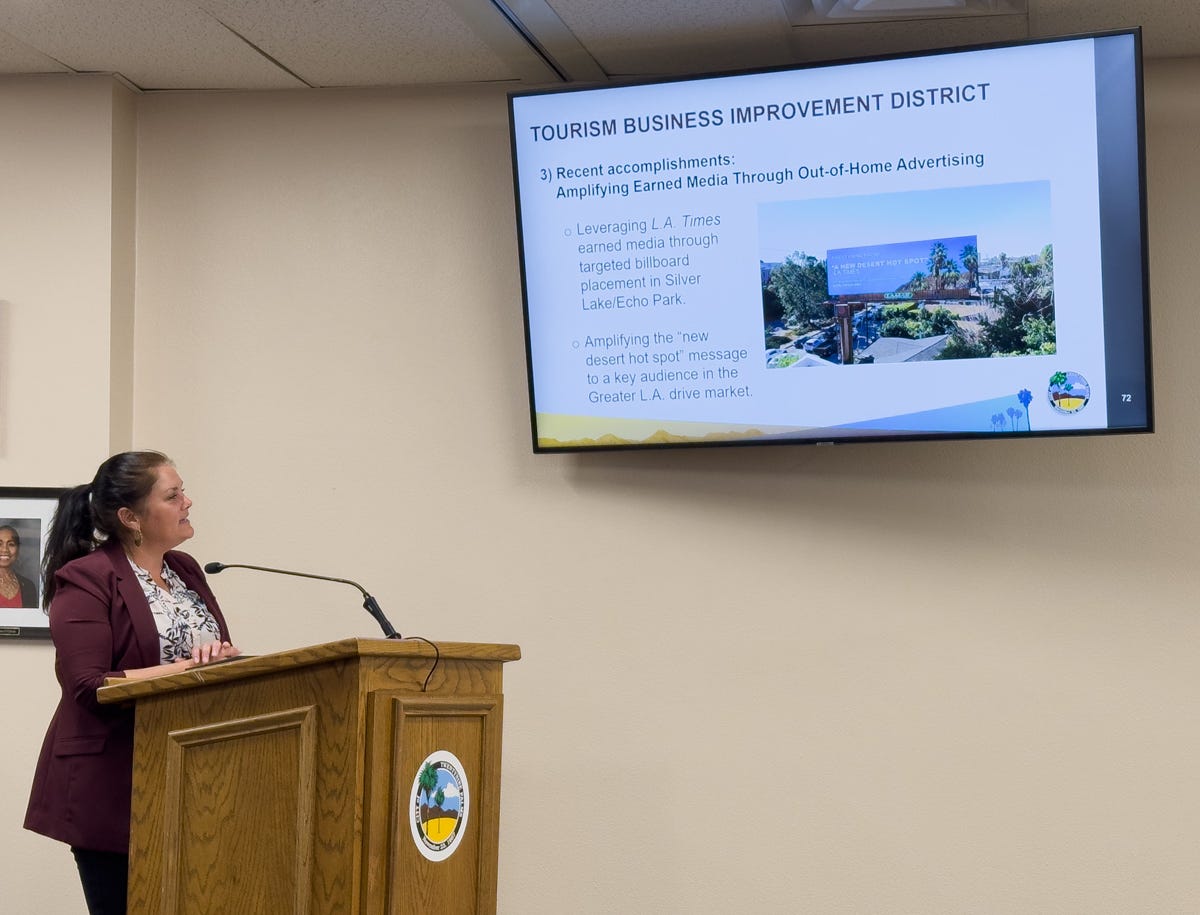
Presenting: Breanne Dusastre, Marketing Director
Purpose: The Tourism Business Improvement District exists through what Ms. Dusastre called a public-private partnership between the City of Twentynine Palms and its lodging property owners. Its core mission is to drive travel and tourism to the City, funded through a 1.5% portion of the Transit Occupancy Tax (TOT) fee paid by overnight visitors. This revenue stream supports tourism marketing efforts independent of City general funds.
Staffing: One full-time, one part-time
Projects / Accomplishments:
Welcomed three new advisory board members: Ashton Ramsey, Ben Uyeda, and Liz Shickler
Sponsored and administered a $200,000 Event Grant Program for a second consecutive year, supporting community events that drive tourism and highlight the city as a cultural destination.
Achieved a 28% increase in social media content engagement.
Continued growth in website organic traffic and business referral clicks.
Recorded the best-ever TBID assessment revenue in the first quarter of 2024, with a 4% increase over the previous year (3% from hotels/RV parks and 6% from vacation rentals).
Secured major earned media including a feature in the LA Times as a result of participation in Visit California’s LA media reception.
Launched a strategic billboard campaign in Silver Lake and Echo Park, Los Angeles, generating 2.6 million impressions.
Planned an upcoming 3-month billboard campaign on I-10 targeting eastbound traffic from major Southern California cities.
Received 32 applications for the second round of event funding, more than double the fall response.
Future needs:
Address concerns from lodging stakeholders about outreach and communication by improving internal time management and partner engagement.
Continue modernizing operations and marketing strategies, including transitioning to the 1994 TBID law for long-term sustainability and operational improvements—which includes renewal every five years, making it much more independent of the City.
Expand partnerships with event organizers and provide more support for events still in the early development stage.
Strengthen visual storytelling through content creators and improved social media.
Finalize and launch I-10 billboard campaign.
Council comment: Octavious Scott, April Ramirez (in public comment)
Public Comment: Mary Jane Binge, Carlos Blandon, Veno Nathraj, Caitlin Gill, Eric Menendez
Desert Trumpet take-away: In the last year, TBID seems to have extended its outreach and enjoyed some success in elevating the City’s profile as a desert destination. Nonetheless, it’s overburdened and understaffed, which raises concerns about burnout, oversight quality, and the capacity to grow and establish meaningful collaborative partnerships. Shifting to the five-year reauthorization cycle threatens to remove crucial annual (if underutilized) City oversight.
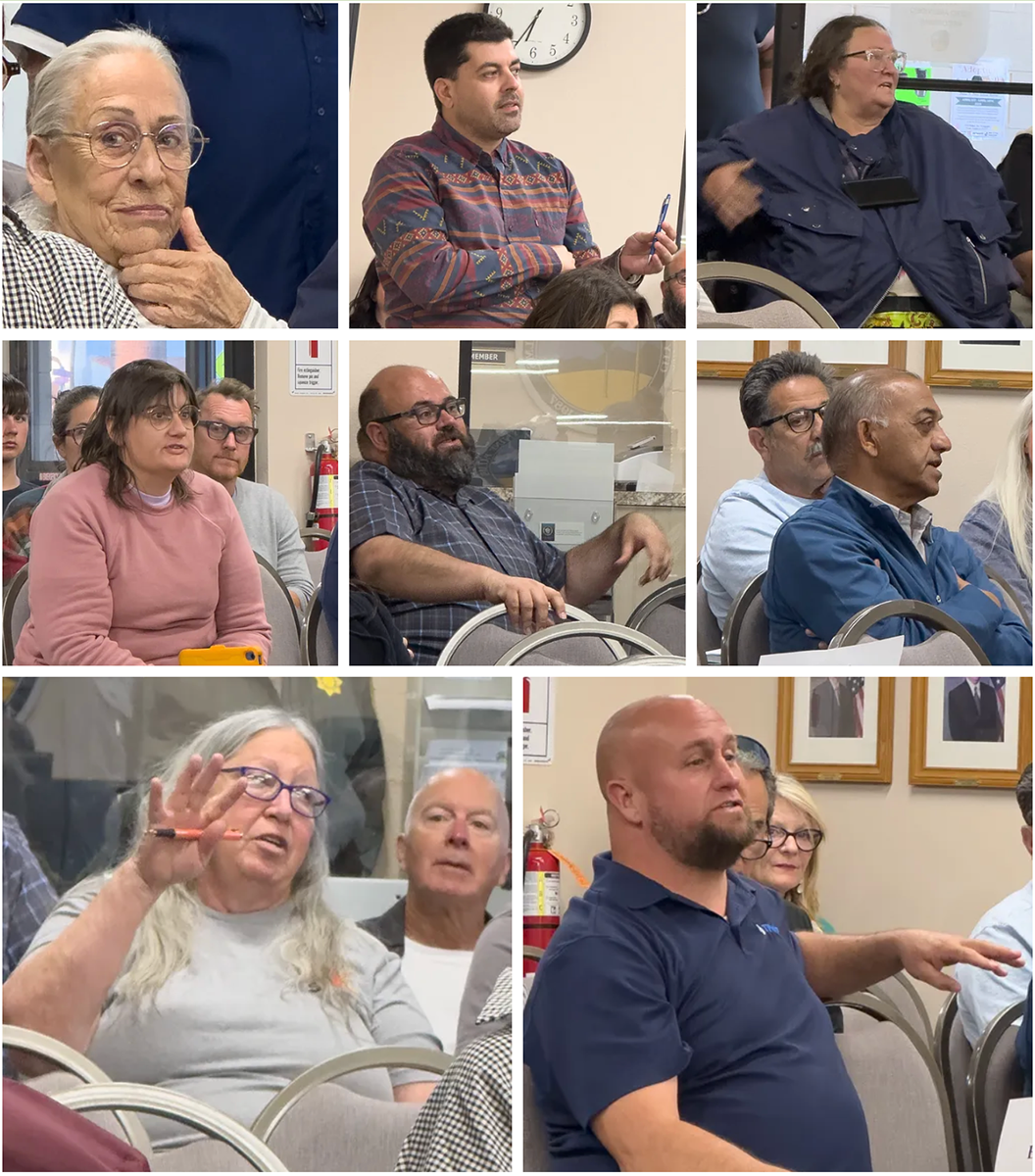
Desert Trumpet is looking for writers! Are you interested? Email your resume and two writing samples to editor@deserttrumpet.org and we’ll be in touch!
Leave your thoughts in the comments below. Please note that we do not allow anonymous comments. Please be sure your first and last name is on your profile prior to commenting. Anonymous comments will be deleted.
Feel free to share this article!
Are you a subscriber?



